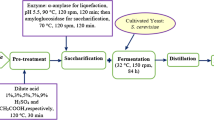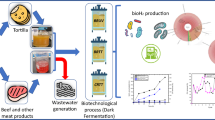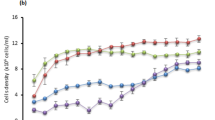Abstract
Natural indigo production from Indigofera plant biomass requires fermentation of biomass, oxidation of fermented broth, settling of oxidized product (indigo), filtration and recovery. In this study, we have investigated roles of physico-chemical parameters during fermentation with respect to product yield. The study showed that water-to-biomass ratio (1:10), fermentation duration (0, 6, 12, 18, 24 h), pH (6–7.5), dissolved oxygen concentration; DO (0.5–3 mg ml−1), oxidation reduction potential ORP (+50 to −300 mV) and temperature (25–40 °C) during fermentation, oxidation and dye recovery from the broth are directly or indirectly related to indigo yield. Biomass fermentation for 12 h at 40 °C incubation temperature yields the highest biogenic indigo (2.84 mg g−1) out of the different experimental conditions.





Similar content being viewed by others
References
Anon (1992) Dyestuffs and pigments. In: Business Monitor PAS 2516. Central Statistical Office, HMSO, London, p 6
Balamurugan G, Selvarajan S (2009) Preliminary photochemical screening and anthelmintic activity of Indigofera tinctoria Linn. Int J Drug Dev Res 1:167–170
Barrera-Islas GA, Ramos-Valdivia AC, Salgado LM, Ponce-Noyola T (2007) Characterization of a β-glucosidase produced by a high specific growth rate mutant of Cellulomonas flavigena. Curr Microbiol 54:266–270. doi:10.1007/s00284-006-0105-7
Berovic M (1999) Scale-up of citric acid fermentation by redox potential control. Biotechnol Bioeng 64:552–557. doi:10.1002/(SICI)1097-0290
Bhatia Y, Mishra S, Bisaria VS (2002) Microbial beta-glucosidase: clones, properties and applications. Crit Rev Biotechnol 22:375–407. doi:10.1080/07388550290789568
Calik P, Yilgor P, Ayhan P, Demir AS (2004) Oxygen transfer effects on recombinant benzaldehyde lyase production. Chem Eng Sci 59:5075–5083
Chan LK, Koay SS, Boey PL, Bhatt A (2010) Effects of Abiotic stress on biomass and anthocyanin production in cell cultures of Melastoma malabathricum. Biol Res 43:127–135. doi:10.4067/S0716-97602010000100014
Chanayath N, Lhieochaiphant S, Phutrakul S (2002) Pigment extraction techniques form the leaves of Indigofera tinctoria Linn. and Baphicacanthus cusia Brem. and chemical structure analysis of their major components. CMU J 1:149–160
Christie RM (2007) Why is indigo blue. Biotechnic & Histochem 82:51–56. doi:10.1080/00958970701267276
Chung JS, Zhu JK, Bressan RA, Hasegawa PM, Shi H (2008) Reactive oxygen species mediate Na+-induced SOS1 mRNA stability in Arabidopsis. Plant J 53:554–565. doi:10.1111/j.1365-313X.2007.03364.x
Ensley BD, Ratzkin BJ, Osslund TD, Simon MJ, Wackett LP, Gibson DT (1983) Expression of naphthalene oxidation genes in Escherichia coli results in the biosynthesis of indigo. Science 222:167–169 (PMID: 6353574)
Epstein E, Nabors MW, Stowe BB (1967) Origin of indigo of woad. Nature 216:547–549. doi:10.1038/216547a0
Ergashev A (2009) Cultivation of Indigo plant, biotechnology of natural dyes and improving the soil ecology. The GEF Small Grants Programme, UNESCO, Tashkent, pp 4–20
Erickson LE, Fung DY (1988) Handbook on anaerobic fermentations. Dekker, New York
Fitzhugh W (1997) Artist’s pigments, a handbook of their history and characteristics, vol 3. Oxford University Press, Oxford
Fredlund E, Blank LM, Schnurer J, Sauer U, Passoth V (2004) Oxygen- and glucose-dependent regulation of central carbon metabolism in Pichia anomala. Appl Environ Microb 70:5905–5911. doi:10.1128/AEM.70.10.5905-5911.2004
Gilbert KG, Cooke DT (2001) Dyes from plants: past usage, present understanding and potential. Plant Growth Regul 34:57–69. doi:10.1023/A:1013374618870
Haucke G, Graness G (1995) Thermal isomerization of indigo. Angew Chem Int Ed Engl 34:67–68. doi:10.1002/anie.199500671
Hong SH, Lee SY (2002) Importance of redox balance on the production of succinic acid by metabolically engineered Escherichia coli. Appl Microbiol Biotechnol 58:286–290. doi:10.1007/s00253-001-0899-y
Jacquemin D, Preat J, Wathelet V, Perpète E (2006) Substitution and chemical environment effects on the absorption spectrum of indigo. J Chem Phys 124(7):074104. doi:10.1063/1.2166018
Jain S, Nayak S, Joshi P (2010) Phytochemical study and physical evaluation of Indigofera tinctoria leaves. Int J Compr Pharm 1:1–5
Karaman S, Diraz E, Comlekcioglu N, Ilcim A, Durdu H, Tansi S (2015) High yielding indigo sources in native Isatis (Brassicaceae) taxa from Turkey. Genet Resour Crop Evol 63:531–543
Kastner JR, Eiteman MA, Lee SA (2003) Effect of redox potential on stationary-phase xylitol fermentations using Candida tropicalis. Appl Microbiol Biotechnol 63:96–100. doi:10.1007/s00253-003-1320-9
Kaufman PB, Cseke LJ, James SW, Harry AD, Briefmann L (1999) Bioseparation of compounds in natural product from plants. CRC Press, London, pp 207–240
Kim JY, Lee JY, Shin YS, Kim GJ (2010) Characterization of an indican hydrolyzing enzyme from Sinorhizobium meliloti. Process Biochem 45:892–896. doi:10.1016/j.procbio.2010.02.017
Laitonjam WS, Wangkheirakpam SD (2011) Comparative study of the major components of the indigo dye obtained from Strobilanthes flaccidifolius Nees. and Indigofera tinctoria Linn. Int J Plant Physiol Biochem 3:108–116
Martin AB, Alcon A, Santos VE, Garcia-Ochoa F (2005) Production of a biocatalyst of Pseudomonas putida CECT5279 for DBT bio desulfurization: influence of the operational conditions. Energy Fuel 19:775–782. doi:10.1021/ef0400417
Martin F, Ebel B, Rojas C, Gervais P, Cayot N, Cachon R (2013) Redox potential: monitoring and role in development of aroma compounds, rheological properties and survival of oxygen sensitive strains during the manufacture of fermented dairy products. Unité Procédés Alimentaires et Microbiologiques 3:71–94. doi:10.5772/51137
Martin-Leake H (1975) An historical memoir of the indigo industry in Bihar. Econ Bot 29:361–371. doi:10.1007/BF02862183
Maugard T, Enaud E, Choisy P, Legoy MD (2001) Identification of an indigo precursor from leaves of Isatis tinctoria (Woad). Phytochemistry 58:897–904
Maugard T, Enaud E, Sayette A, Choisy P, Legoy MD (2002) β-Glucosidase-catalyzed hydrolysis of indican from leaves of Polygonum tinctorium. Biotechnol Process 18:1104–1108. doi:10.1021/bp025540
Minami Y, Kanafuji T, Miura K (1996) Purification and characterization of a β-glucosidase from Polygonum tinctorium, which catalyzes preferentially the hydrolysis of indican. Biosci Biotech Biochem 60:147–149. doi:10.1271/bbb.60.147
Minami Y, Takao H, Kanafuji T, Miura K, Kondo M (1997) β-Glucosidase in the indigo plant: intracellular localization and tissue specific expression in leaves. Plant Cell Physiol 38:1069–1074
Morison JIL, Lawlor DW (1999) Interactions between increasing CO2 concentration and temperature on plant growth. Plant Cell Environ 22:659–682. doi:10.1046/j.1365-3040.1999.00443.x
Narayan MS, Thimmaraju R, Bhagyalakshmi N (2005) Interplay of growth regulators during solid state and liquid state batch cultivation of anthocyanin producing cell line of Daucus carota. Process Biochem 40:351–358. doi:10.1016/j.procbio.2004.01.009
Puchalska M, Pawlak KP, Zadrozna I, Hryszko H, Jarosz M (2004) Identification of indigoid dyes in natural organic pigments used in historical art objects by high-performance liquid chromatography coupled to electrospray ionization mass spectrometry. J Mass Spectrom 39:1441–1449. doi:10.1002/jms.728
Roessler A, Jin X (2003) State of the art technologies and new electrochemical methods for the reduction of vat dyes. Dyes Pigment 59:223–235. doi:10.1016/S0143-7208(03)00108-6
Sandoval S, Mendez C, Cardador A (2010) Preliminary study of the indican production in tissue cultures of Indigofera suffruticosa Mill. 8:1–7. http://www.e-gnosis.ndg.mx/vol8/art4
Schunk E (1955) On the formation of indigo blue. Philos Mag Ser. 10:74–95
Seldes A, Burucua JE, Maier MS, Abad G, Jauregui A, Siracusano G (1999) Blue pigments in South American painting (1610–1780). J Am Inst Conserv 38:100–123. doi:10.2307/3180041
Sewekow U (1988) Natural dyes—an alternative to synthetic dyes. Melliand Textilber. 69:271–276
Shin Y, Yoo DI, Kim K (2014) Process balance of natural indigo production based on traditional Niram method. Text Color Finish 24:253–259. doi:10.5764/TCF.2012.24.4.253
Singh R, Sharma S, Sharma V (2015) Comparative and quantitative analysis of antioxidant and scavenging potential of Indigofera tinctoria Linn. extracts. J Integr Med 13:269–278. doi:10.1016/S2095-4964(15)60183-2
Stoker KG, Cooke DT, Hill DJ (1998a) An improved method for the large-scale processing of woad (Isatis tinctoria) for possible commercial production of woad indigo. J Agric Eng Res 7:315–320. doi:10.1006/jaer.1998.0329
Stoker KG, Cooke DT, Hill DJ (1998b) Influence of light on natural indigo production from woad (Isatis tinctoria). Plant Growth Regul 25:181–187. doi:10.1023/A:1006042331385
Teanglum A, Teanglum S, Saithiong A (2012) Selection of indigo plant varieties and other plants that yield Indigo dye. Proc Eng 32:184–190. doi:10.1016/j.proeng.2012.01.1255
Toonkool P, Metheenukul P, Sujiwattanarat P, Paiboon P, Tongtubtim N, Keudat-Carins M (2006) Expression and purification of dalcochinase, a β-glucosidase from Dalbergia cochinchinensis Pierre, in yeast and bacterial hosts. Protein Express Purif 48:195–204. doi:10.1016/j.pep.2006.05.011
Watson J (1991) Textiles and the environment. Special report no. 2150. In: The Economist Intelligence Unit, pp 117–140
Wu E, Komolpis K, Wang HY (1999) Chemical extraction of indigo from Indigofera tinctoria while attaining biological integrity. Biotechnol Tech 13:567–569. doi:10.1023/A:1008952016185
Xu Q, Li S, Huang H, Wen J (2012) Key technologies for the industrial production of fumaric acid by fermentation. Biotechnol Adv 30:1685–1696. doi:10.1016/j.biotechadv.2012.08.007
Yu K, Murthy HN, Hahn E, Paek K (2005) Ginsenoside production by hairy root cultures of Panax ginseng: influence of temperature and light quality. Biochem Eng J 23:53–56. doi:10.1016/j.bej.2004.07.001
Zhang HT, Zhan XB, Zheng ZY, Wu JR, English N, Yu XB, Lin CC (2012) Improved curdlan fermentation process based on optimization of dissolved oxygen combined with pH control and metabolic characterization of Agrobacterium sp. ATCC 31749. Appl Microbiol Biotechnol 93:367–379. doi:10.1007/s00253-011-3448-3
Acknowledgements
The authors are thankful to CSIR for financial support to SD for this research. Authors are also thankful to the Director CSIR-NEERI for permission to carry out the research.
Author information
Authors and Affiliations
Corresponding author
Ethics declarations
Conflict of interest
The authors state no conflict of interest for this work.
Rights and permissions
About this article
Cite this article
Dutta, S., Roychoudhary, S. & Sarangi, B.K. Effect of different physico-chemical parameters for natural indigo production during fermentation of Indigofera plant biomass. 3 Biotech 7, 322 (2017). https://doi.org/10.1007/s13205-017-0923-2
Received:
Accepted:
Published:
DOI: https://doi.org/10.1007/s13205-017-0923-2




